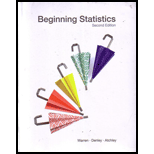
A confidence Construct and interpret interval for the true difference between the two population means.
Answer to Problem 15E
Solution:
The value of the margin of error is 0.7880 and 99% confidence interval for the true difference between the mean numbers of cavities for children whose diets are high in sugar and those whose diets are low in sugar, is
Explanation of Solution
Given Information:
The mean number of cavities whose diet is high in sugar or.
It is assumed that Population variances must be equal.
Formula used:
The confidence interval for the difference between two population means for independent data sets is given by
Or
Where
and margin of error of a confidence interval for the difference between two population means is given by
Where,
Calculation:
The margin of error for given populations is,
For populations where the variances are assumed to be equal, the number of degrees of freedom is calculated as,
Substitute 10 for
Since the level of confidence is 99%, then the level of significance is given as,
Substitute 0.01 for
For the
Substitute the values 2.845 for
The confidence interval is
Interpretation:
The 99% confidence interval for the true difference between the mean numbers of cavities for children whose diets are high in sugar and the children, whose diets are low in sugar, ranges from
Want to see more full solutions like this?
Chapter 9 Solutions
Beginning Statistics, 2nd Edition
 MATLAB: An Introduction with ApplicationsStatisticsISBN:9781119256830Author:Amos GilatPublisher:John Wiley & Sons Inc
MATLAB: An Introduction with ApplicationsStatisticsISBN:9781119256830Author:Amos GilatPublisher:John Wiley & Sons Inc Probability and Statistics for Engineering and th...StatisticsISBN:9781305251809Author:Jay L. DevorePublisher:Cengage Learning
Probability and Statistics for Engineering and th...StatisticsISBN:9781305251809Author:Jay L. DevorePublisher:Cengage Learning Statistics for The Behavioral Sciences (MindTap C...StatisticsISBN:9781305504912Author:Frederick J Gravetter, Larry B. WallnauPublisher:Cengage Learning
Statistics for The Behavioral Sciences (MindTap C...StatisticsISBN:9781305504912Author:Frederick J Gravetter, Larry B. WallnauPublisher:Cengage Learning Elementary Statistics: Picturing the World (7th E...StatisticsISBN:9780134683416Author:Ron Larson, Betsy FarberPublisher:PEARSON
Elementary Statistics: Picturing the World (7th E...StatisticsISBN:9780134683416Author:Ron Larson, Betsy FarberPublisher:PEARSON The Basic Practice of StatisticsStatisticsISBN:9781319042578Author:David S. Moore, William I. Notz, Michael A. FlignerPublisher:W. H. Freeman
The Basic Practice of StatisticsStatisticsISBN:9781319042578Author:David S. Moore, William I. Notz, Michael A. FlignerPublisher:W. H. Freeman Introduction to the Practice of StatisticsStatisticsISBN:9781319013387Author:David S. Moore, George P. McCabe, Bruce A. CraigPublisher:W. H. Freeman
Introduction to the Practice of StatisticsStatisticsISBN:9781319013387Author:David S. Moore, George P. McCabe, Bruce A. CraigPublisher:W. H. Freeman





